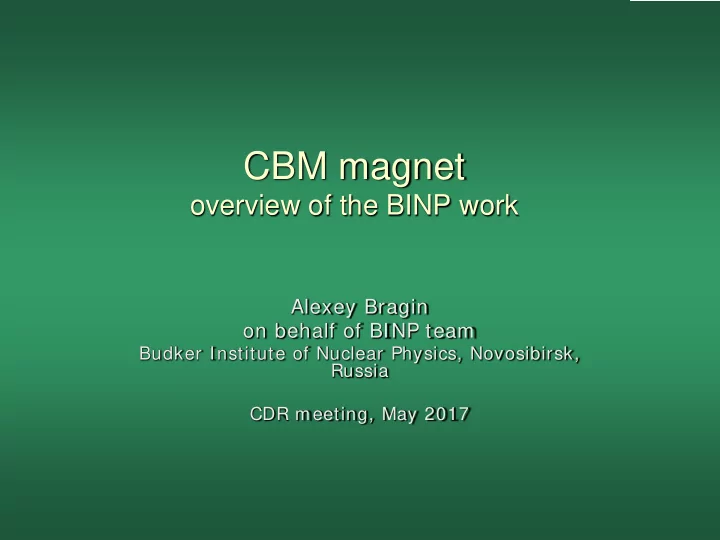

CBM magnet overview of the BINP work Alexey Bragin on behalf of BINP team Budker Institute of Nuclear Physics, Novosibirsk, Russia CDR meeting, May 2017
Design parameters of the CBM magnet to be realized Geometry - Opening angle: ± 25° vertically, ± 30° horizontally from the target - Free aperture: 1.44 m vertically x 1.8 m horizontally, no conical geometry - Distance target- magnet core end: 1m (STS detector must fit in) - Total length: 1.5 m - Space upstream of the magnet: < 1 m Magnetic field - Field integral within STS detector (along straight lines): 0,972 Tm -> max. Field ≈ 1 T, depending on the magnet length - Field integral variation over the whole opening angle along straight lines: ≤ 20% (± 10% ) - Fringe field downstream < reasonable value of the order of 50 to 100 Gauss at a distance of 1.6 m from the target (RICH only) Operating conditions - Operates at both polarities - 100% duty cycle, 3 months/ year, 20 years - No real time restriction on the ramp: 1 hour up ramp - Radiation damage (< 10MG for organics): no problem - Radiation Energy deposit in the cryosystem: max. 1 W
Design parameters of the CBM magnet to be realized, continued Assembly - Field clamps dismountable for MUCH - Assembly in situ - Weight restriction: crane 30 tons (including lifting jacks) - Maximum floor load: 100 tons/ m2 - beam height over the floor: 5.8 m Alignment - Position accuracy: ± 0.2 mm - Orientation accuracy (roll): ± 0.5 mrad The requirements given above are mandatory. Remark: the free aperture was increased from 1.4m (TDR) to 1.44 m. However, the integral field was decreased in order to keep the nominal current the same as in the TDR. The CBM superconducting dipole will be designed as follows: • Warm iron yoke ( huge vertical and horizontal balks) • Warm round (tapered) poles • Removable field clamps • cylindrical NbTi coils wound on cylindrical bobbin , cooled with LHe • Thermal shield cooled with Helium gas (50-80K) • Two independent cold masses and cryostats • Vertical forces transferred from the coil to the cryostat and finally to the yoke • Normal conducting leads
Design work in BINP BINP is responsible for the CBM magnet design. BINP designers are: Sergey Pivovarov – general management Vasily Syrovatin – coil design, will start in August 2017 Mikhail Kholopov – cryostat and cryogenics, started in April 2017 Sergey Peshekhonov – iron yoke The current work was started from the TDR developed previously.
General view of the CBM magnet
The CBM magnet general view
Coil design Stored energy – 5 MJ
Cold mass suspended on the tie rods
Cooling of the CBM magnet RD RM7 Single cryostat cooling. Vc1 current leads gas return line Liquid helium at 4.5 K 1.1 bar Vc2 PV3 from the cryostat goes T11 P11 down to the coils Cryostat GHe LM Ts3 Gaseous helium goes up due to gravitation. Ts4 Coil design should not Tc1 COIL 1 have gas pockets. PV4 Ts5 Tc2 COIL 2
View of the cryostat The cryostat is placed by the top side of the detector.
Cryostat view 2
Interface to the detector as example In further work BINP people responsible for the control systems should specify conditions demanded for FAIR. Typically BINP provides the required control systems as presented on these figures.
Assembling
Status of BINP work on the CBM magnet Principle problems for manufacturing of the CBM magnet by BINP are not seen. Test place in BINP will be ready by end of 2018. LHe supply is ~ 500 l/ day. Subcontractors for manufacturing the superconducting cable and the iron yoke are ready to work. The discussions will be going on the cryogenics design (details of operations) and the coil design (proposal to change the coil design). Proposal to finalize the CDR agreements by July 2017 within the CDR document. For the preliminary design (October 2017) the coil design should be confirmed.
Recommend
More recommend